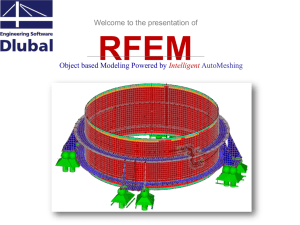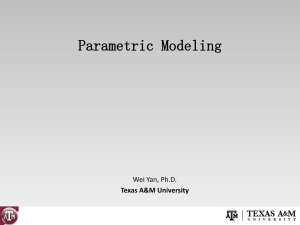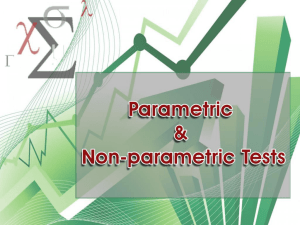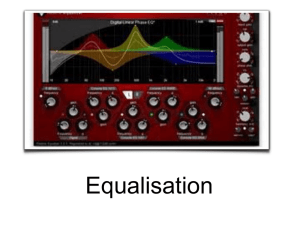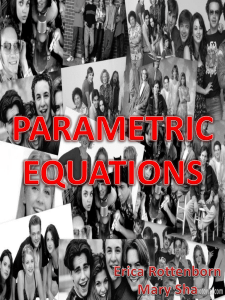16.6 Parametric Surfaces & Areas
advertisement
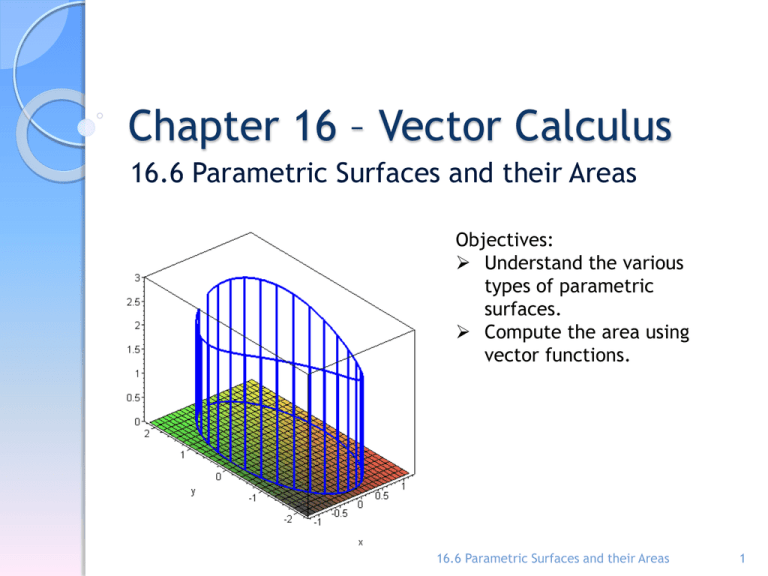
Chapter 16 – Vector Calculus 16.6 Parametric Surfaces and their Areas Objectives: Understand the various types of parametric surfaces. Compute the area using vector functions. 16.6 Parametric Surfaces and their Areas 1 Vector Calculus So far, we have considered special types of surfaces: ◦ ◦ ◦ ◦ Cylinders Quadric surfaces Graphs of functions of two variables Level surfaces of functions of three variables 16.6 Parametric Surfaces and their Areas 2 Vector Calculus Here, we use vector functions to describe more general surfaces, called parametric surfaces, and compute their areas. Then, we take the general surface area formula and see how it applies to special surfaces. 16.6 Parametric Surfaces and their Areas 3 Introduction We describe a space curve by a vector function r(t) of a single parameter t. Similarly, we can describe a surface by a vector function r(u, v) of two parameters u and v. 16.6 Parametric Surfaces and their Areas 4 Equation 1 We suppose that r(u, v) = x(u, v) i + y(u, v) j + z (u, v) k is a vector-valued function defined on a region D in the uv-plane. 16.6 Parametric Surfaces and their Areas 5 Equation 2 The set of all points (x, y, z) in 3 such that x = x(u, v) y = y(u, v) z = z(u, v) and (u, v) varies throughout D, is called a parametric surface S. ◦ Equations 2 are called parametric equations of S. 16.6 Parametric Surfaces and their Areas 6 Example 1 – pg. 1132 #2 Determine whether the points P and Q lie on the given surface. r u , v u v, u v, u v 2 2 P 3, 1, 5 , Q 1, 3, 4 16.6 Parametric Surfaces and their Areas 7 Parametric Surfaces Each choice of u and v gives a point on S. By making all choices, we get all of S. In other words, the surface S is traced out by the tip of the position vector r(u, v) as (u, v) moves throughout the region D. 16.6 Parametric Surfaces and their Areas 8 Example 2 – pg. 1132 # 5 Indentify the surface with the given vector equation. r (s, t ) s, t, t s 2 2 16.6 Parametric Surfaces and their Areas 9 Example 3 – pg. 1132 Match the equations with the graphs labeled I – VI and give reasons for your answers. 16.6 Parametric Surfaces and their Areas 10 Parametric Representation In Example 1 we were given a vector equation and asked to graph the corresponding parametric surface. ◦ In the following examples, however, we are given the more challenging problem of finding a vector function to represent a given surface. ◦ In the rest of the chapter, we will often need to do exactly that. 16.6 Parametric Surfaces and their Areas 11 Example 4 Find a parametric representation of the sphere x 2 + y 2 + z2 = a 2 16.6 Parametric Surfaces and their Areas 12 Applications – Computer Graphics One of the uses of parametric surfaces is in computer graphics. The figure shows the result of trying to graph the sphere x2 + y2 + z2 = 1 by: ◦ Solving the equation for z. ◦ Graphing the top and bottom hemispheres separately. 16.6 Parametric Surfaces and their Areas 13 Computer Graphics Part of the sphere appears to be missing because of the rectangular grid system used by the computer. 16.6 Parametric Surfaces and their Areas 14 Computer Graphics The much better picture here was produced by a computer using the parametric equations found in the example 2. 16.6 Parametric Surfaces and their Areas 15 Parameters In general, a surface given as the graph of a function of x and y—an equation of the form z = f(x, y)—can always be regarded as a parametric surface by: ◦ Taking x and y as parameters. ◦ Writing the parametric equations as x = x y = y z = f(x, y) 16.6 Parametric Surfaces and their Areas 16 Example 5 Find a parametric representation for the surface. 20. T he part low er half of the ellipsoid 2 x 4 y z 1. 2 2 2 16.6 Parametric Surfaces and their Areas 17 Tangent Planes We now find the tangent plane to a parametric surface S traced out by a vector function r(u, v) = x(u, v) i + y(u, v) j + z(u, v) k at a point P0 with position vector r(u0, v0). 16.6 Parametric Surfaces and their Areas 18 Tangent Planes Keeping u constant by putting u = u0, r(u0, v) becomes a vector function of the single parameter v and defines a grid curve C1 lying on S. 16.6 Parametric Surfaces and their Areas 19 Tangent Planes – Equation 4 The tangent vector to C1 at P0 is obtained by taking the partial derivative of r with respect to v: rv x v (u 0 , v0 ) i y v (u 0 , v0 ) j z v (u 0 , v0 ) k 16.6 Parametric Surfaces and their Areas 20 Tangent Planes Similarly, keeping v constant by putting v = v0, we get a grid curve C2 given by r(u, v0) that lies on S. Its tangent vector at P0 is: ru x u (u 0 , v0 ) i y u (u 0 , v0 ) j z u (u 0 , v0 ) k 16.6 Parametric Surfaces and their Areas 21 Smooth Surface If ru x rv is not 0, then the surface is called smooth (it has no “corners”). ◦ For a smooth surface, the tangent plane is the plane that contains the tangent vectors ru and rv, and the vector ru x rv is a normal vector to the tangent plane. 16.6 Parametric Surfaces and their Areas 22 Example 6 Find an equation of the tangent plane to the given parametric surface at the specified point.. 36. r ( u , v ) uv i u sin v j v cos u k u 0, v 16.6 Parametric Surfaces and their Areas 23 Definition 6 – Surface Area Suppose a smooth parametric surface S is: ◦ Given by the equation : r(u, v) = x(u, v) i + y(u, v) j + z(u, v) k (u, v) D ◦ Covered just once as (u, v) ranges throughout the parameter domain D. 16.6 Parametric Surfaces and their Areas 24 Definition 6 continued Then, the surface area of S is A(S ) | r r | dA u v D where: ru x u i y u j z u k rv x v i y v j 16.6 Parametric Surfaces and their Areas z v k 25 Surface Area of the Graph of a Function Now, consider the special case of a surface S with equation z = f(x, y), where (x, y) lies in D and f has continuous partial derivatives. ◦ Here, we take x and y as parameters. ◦ The parametric equations are: x=x y=y z = f(x, y) 16.6 Parametric Surfaces and their Areas 26 Surface Area of the Graph of a Function Then, the surface area formula in Definition 6 becomes: 2 A( S ) D 2 z z 1 dA x y (this is formula 9) 16.6 Parametric Surfaces and their Areas 27 Example 7 Find the area of the surface. a . T h e p art o f th e p lan e 2 x 5 y z 1 0 th at lie s in sid e th e cylin d er x y 9 . 2 2 b . T h e p art o f th e p lan e w ith th e vecto r eq u atio n r (u , v ) 1 v , u 2 v , 3 5u v th at is g iven b y 0 u 1, 0 v 1 . 16.6 Parametric Surfaces and their Areas 28 Example 8 – pg. 1133 Find the area of the surface. 4 4 . T h e p art o f th e su rface z 1 3 x 2 y th e trian g le w ith vertices 2 th at lies ab o ve 0, 0 , 0,1 , an d 2,1 . 4 6. T h e p art o f th e p arab o lo id x y z 2 2 th at lies in sid e th e cylin d er y z 9 . 2 2 4 8 . T h e h elico id (o r sp iral ram p ) w ith th e ve cto r eq u atio n r ( u , v ) u co s v , u sin v , v 0 u 1, 0 v . th at is g iven b y 16.6 Parametric Surfaces and their Areas 29

